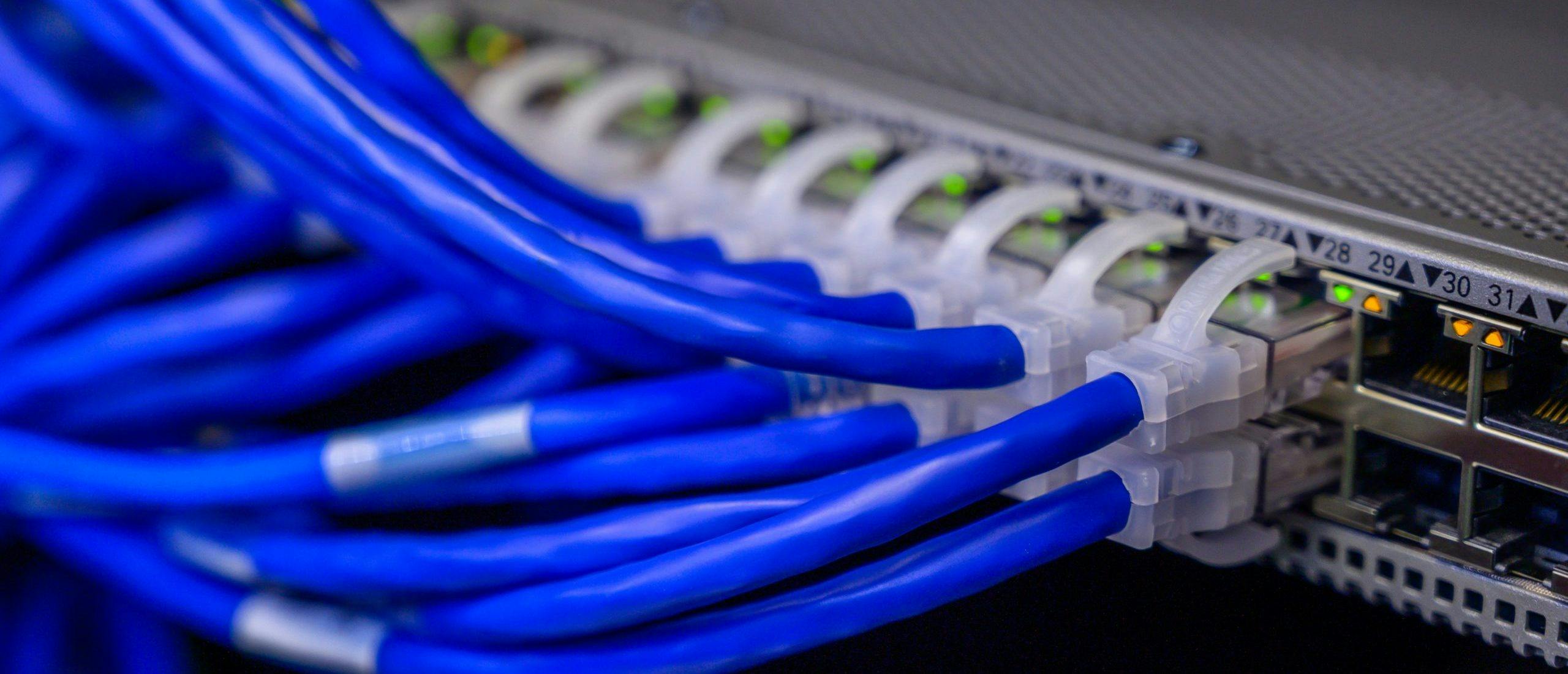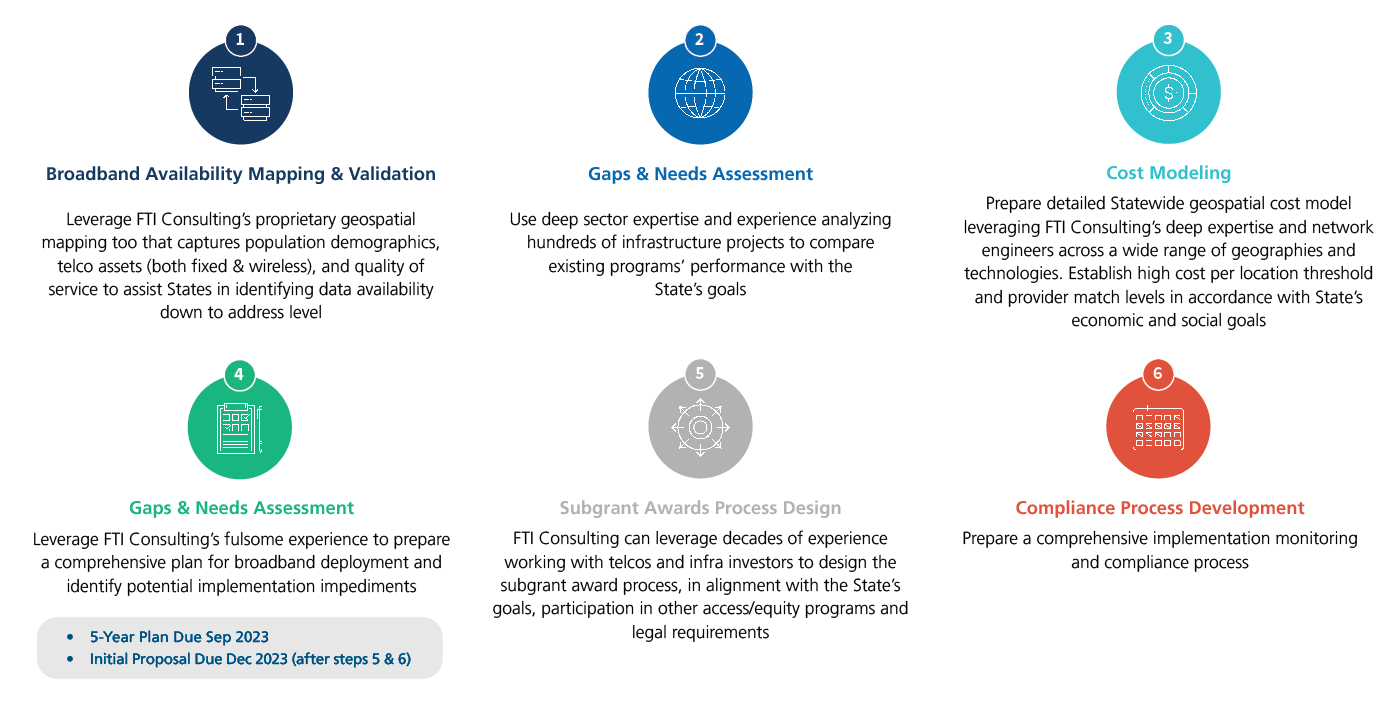“BEAD” and bridging the digital divide
“BEAD” and bridging the digital divide
What is BEAD? The Broadband Equity, Access, and Deployment Program (“BEAD”) is a $42.45 billion formula-based state grant program for deployment of broadband to unserved and underserved communities, with each state set to receive, at a minimum, $100 million, with incremental funding to be formulaically allocated.
Insights ahead
The BEAD program has the potential to be transformational for states in closing the remaining connectivity gaps.
The program is structured so that each state will be in control and will play a key role in shaping its own broadband access for generations.
A state’s BEAD planning should begin with an understanding of the key lessons learned in prior grant programs, e.g., RDOF, etc.
Careful consideration and planning will be required by state broadband offices and should be tailored to the specific conditions, geographies, demographics and goals of each state.
Why broadband access is important
Bridging the digital divide and expanding broadband access to rural areas is a critical need in the United States. It is not just a matter of convenience, but a matter of equity and ensuring that all Americans have access to the resources they need to thrive. Expanding broadband access to rural areas is critical for ensuring that all Americans have access to educational opportunities, healthcare services, social connections, and economic development. It is imperative that we invest in these initiatives to ensure that no one is left behind in the digital age.
According to the National Center for Education Statistics, only 79 percent of households with school-age children in rural areas have internet access, compared to 94 percent of households in other areas. This lack of access to reliable internet can put rural students at a disadvantage compared to their urban counterparts, hindering their educational opportunities and limiting their prospects.
Access to broadband internet is also essential for economic development, particularly in rural areas where traditional industries such as agriculture and manufacturing are in decline or are at risk of getting boxed out by a lack of competitive advantage and where internet-connected devices and sensors are becoming critical to maximizing yields. A study by the Brookings Institution found that expanding broadband access in rural areas could create up to 360,000 new jobs and add $47 billion to the U.S. economy each year.
Moreover, without reliable internet access, patients in rural areas may not be able to access telemedicine services, thereby leading to a lack of healthcare access and to poorer health outcomes.
Lack of internet access will also lead to the limiting of entrepreneurship and innovation. As of the last FCC report, 25 million Americans lack access to Broadband internet, and the majority of this group live in rural areas. This reality will continue to hinder the ability of entrepreneurs and small businesses in rural regions to compete in the digital economy and will limit economic growth and innovation.
Trends Increasing the Importance of Rural Broadband
Work from Home: A study completed in July 2022 by OwlLabs in collaboration with Global Workplace Analytics found that 16% of companies globally are fully remote and ~62% of employees aged 22 – 65 work remotely at least occasionally. The number of remote opportunities is expected to continue rising upwards of 25% by 2025.
E-Learning: The U.S. e-learning market is expected to continue growing at a CAGR of 12.5% from 2021 to 2027.
Telehealth: The U.S. telehealth market size was valued at $23.5 billion in FY2021 and is expected to grow at a CAGR of 44.4% from 2022 to 2028.

Means of delivering rural broadband access
A variety of technologies are currently used to provide broadband internet services, each with different capabilities and limitations, investment requirements (some of which leverage existing infrastructure) and ongoing operating costs.
As of today, the most proven technology available to deliver on the deployment of future-proof networks is Fiber, with Fiber-to-the-Premise (“FTTP”) deployments becoming the preferred method of ISP operators to deploy high-speed, symmetrical internet service to their existing and adjacent footprints. Figure 14 illustrates the positioning of competing technologies in terms of ongoing maintenance costs and new construction investment. The relative size of each “bubble” indicates speed potential, with a larger bubble indicating greater speed.
Fiber can provide the highest delivered speeds in both the upstream and downstream directions and has low maintenance costs. Fiber has the highest initial construction costs when compared to options that can leverage existing infrastructure (such as DSL or cable). The high initial capital requirements benefits first movers since it serves as a barrier to entry. However, it usually requires higher population densities and/or socioeconomic demographic levels to meet the required return thresholds to substantiate the investment.
Hybrid Fiber-Coax (“HFC”) technology is an upgrade to traditional cable infrastructure and allows broadband deployment using a combination of fiber cable and existing coaxial cable (with fiber cable feeding the coaxial cable at a junction point referred to as a fiber node) that converts the optical signal to an electrical signal. Because cable companies own coaxial infrastructure that connects to virtually every consumer location in the country, cable companies present the prime competitor to MetroNet. Cable companies provide broadband services using a technology referred to as Data Over Cable Service Interface Specification (“DOCSIS”). The most recent specification is called DOCSIS 3.1, which is currently capable of providing competitive download speeds to fiber, but only under certain circumstances.
Satellite internet service is available virtually everywhere in the U.S., making it a popular choice in rural areas. Satellite internet service is generally slow (especially in the upload direction), expensive and suffers from high latency. It is also susceptible to data degradation due to poor weather conditions. Furthermore, providers often expect customers to sign a long-term agreement to use the antennae needed to receive and transmit signals. However, satellite service has benefits; it is ubiquitous, offers the speeds required for many residential customers, and has a quick post-disaster recovery time.
Fixed Wireless technology uses a stationary antenna to transmit data to a customer’s premises. Speeds produced by fixed wireless can vary from under 1 Mbps to more than 1 Gbps, depending on equipment, configuration, and distance. In comparison to fiber options, fixed wireless is limited by line of sight, has lower speed potential, suffers from weather-related interference and is suited to a limited demographic: multi-tenant consumer locations and businesses less dependent on data speed and reliability for their everyday operations. Fixed wireless service is in relatively low use today.
FIGURE 1. Comparison of Broadband Technologies: Cost to Construct/Maintain vs. Speed

The challenges of deploying rural broadband: Experiences on the ground
Mapping data and proper identification of unserved/underserved areas
The lack of highly accurate and validated serviceability data has hindered government and private operators alike in their ability efficiently to allocate resources where it is needed most.
Inaccurate serviceability data can have significant impacts on internet service provider (“ISP”) operators. It can result in overestimating the demand for broadband services in certain areas, leading to overbuilding in some places while leaving other areas without adequate coverage. This can lead to inefficient use of resources, higher deployment costs, and reduced profitability for ISPs.
Additionally, inaccurate mapping data can also cause ISPs to be unable to identify areas that need broadband services, resulting in inadequate service deployment and potential loss of customers to competitors. Overall, inaccurate mapping data can negatively impact the business operations and profitability of ISPs.
Challenging economic models are highly sensitive to minor changes in demand and/or cost inputs
Lack of existing infrastructure, low population density, and lower socio-economic demographic leads to high deployment costs and lower return potential for operators.
Prior programs, which have allocated funds to operators primarily to match network deployment capex costs, have seen failed and/or delayed deployments due to unforeseen demand and cost inputs, e.g., low penetration levels, labor shortages, material inflation, supply chain delays, etc., all of which quickly result in negative NPV models for private sector partners.
Broadband availability does not always mean broadband access and adoption
Even when broadband becomes available in rural areas, there may be barriers to adoption because of low digital literacy rates, lack of awareness of available services, rate of technological advances, or affordability concerns.
In addition, rural areas are often slower to adopt new technologies and hardware, making it challenging to keep pace with the latest broadband offerings and infrastructure and driving continuing access and affordability gaps even well after broadband service is available in rural communities.
Broadband availability requires coordination, incentivization, and accountability across public/private sectors as well as multiple levels and branches of government
Deploying rural broadband requires political will and support at all levels of government (from federal to state to local communities) as well as adequate funding and resources to support the deployment and maintenance of infrastructure, as well as the ongoing community work to drive adoption.
Regulatory barriers at different federal, state and local levels can also create a difficult maze through which local operators must navigate. Restrictions on the types of infrastructure that can be installed, or the types of services offered, can make deployment, maintenance and operating rural networks more time-intensive and costly.

What states need to get right
1. Validation of serviceability data is a critical pre-requisite to a successful program
States need to take ownership of the data verification process through their own engineering and technical review process, ensuring that the mapping data the FCC and NTIA propose to use for the distribution of grants is accurate and complete. This will require coordination with local governments as well as private partnerships as needed to ensure adequate technical expertise.
2. Program governance and transparency are key roles of the state
Successful leadership in the BEAD program begins with transparency in the process. States must begin with a clear and detailed subgrant application process and establish a rigorous verification and auditing process to ensure that funds are allocated efficiently and program goals can be met in reasonable time frames.
Equally important to program transparency is a strong governance model. States will have different approaches, but the key will be ensuring a structure that puts the right resources at the right program touchpoints and empowers them with adequate authority and funding to deliver properly.
States should carefully consider the structural changes necessary to ensure coordination and accountability across multiple agencies and levels of government (from state to local).
3. Building and maintaining a network of partnerships, prioritizing local government and community input
Soliciting input from local communities and critical “on the ground” stakeholders early on in the planning and governance of BEAD will result in a higher likelihood of deployment programs properly addressing the needs of local communities. Missing this early-in-the-planning process will only lead to increased costs to deploy and lower adoption being realized once it is too late to course-correct.
States should take a comprehensive look at the roadmap from planning through deployment through adoption and assess where they need to lead and where they can more efficiently utilize a partner network while monitoring outcomes.
4. Subgrant award program should aim to drive competition while ensuring validation of operator capabilities, with a bias towards FTTP
State broadband offices should seek input from many sources including private ISPs to ensure that the grant process is fair and equitable and that the funding criteria are realistic and achievable.
Importantly, initial subgrant awards should rely on a comprehensive assessment of operators’ capabilities to avoid going down a path with operators that may not have the ability to successfully deliver on what they are marketing, as was witnessed during the RDOF process. FTTP deployments should be the base technology where topography and foliage are less of a concern, supplemented with emerging technologies in particularly challenging terrains.
5. Understanding the deployment cost and economic model to ensure efficient resource allocation
States need a thorough understanding of the economic model and impact from inflationary pressures as well as expected impacts from other key federal programs such as Build America, Buy America Act (“BABAA”), etc.
The high-cost funding threshold and sub-grant award system need to account for these cost inputs and maximize the allocation of resources in line with deployment feasibility.
6. Monitor progress, evaluate outcomes and disperse KPIs
State broadband offices should monitor the progress of BEAD-funded projects and evaluate their outcomes to ensure that they are meeting the grant requirements and achieving their intended goals.
This is achieved by standing up a system for regular data retrieval, continual progress reports, and independent audits, to ensure that BEAD funds are being used effectively. States are likely to need to build partnerships across the supply chain to evaluate BEAD-funded projects and identify areas for improvement.
7. Bridge the gap between availability and adoption; prioritize digital equity and literacy
State broadband offices should prioritize digital equity and literacy by providing funding for digital literacy and training programs in rural areas. This can be achieved by providing grants to community organizations, schools and libraries to help them provide digital literacy training to their communities.
State broadband offices should work with engineering experts and data analytics firms to identify areas of need and develop targeted training programs that address the unique needs of rural communities.

Where FTI Consulting can help
FTI Consulting is well-positioned to assist states in their BEAD planning. Some of the core areas where states require expertise include Broadband Availability Mapping & Validation, Cost Modeling, Subgrant Award Process Designing, and Compliance Process Development.


